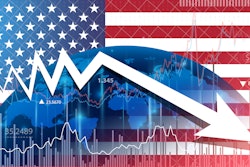
In the 1980s, brown suits exploded in men's fashion, a reflection of the then trending brown suits sported by former U.S. President Ronald Reagan. Now, it would be a truly rare occurrence to see a brown suit being worn by businessmen out in the wild. Similarly, people are currently camping out all night in big box store parking lots to get their hands on the latest Stanley tumbler, and Taylor Swift has the No. 1 grossing concert series of all time. Although the consumer market has shifted from the 1980s, one thing is truer now than ever before -- we are living in a consumer-driven buying power economy, driven by trends and outside forces. Buyers are extremely impressionable so it does not take much to have preferences change.
In addition to a consumer-based economy, it is absolutely certain that Americans are living in a hyper-charged, polarized political climate — at least according to the media. While people are defending the right or the left, there's one issue that all Americans can agree on: the need for strong supply chains. After the collective experience of supply chain shortfalls with the onset of the COVID-19 pandemic, Americans are sure to not take for granted the convenience of products like toilet paper and baby formula again. Beyond the general public though are the people that make up the supply chain itself, and manufacturers are feeling the unease of the unknown with the upcoming 2024 U.S. Presidential election.
Here are four things that the 2024 Presidential nominees need to consider when it comes to the supply chain:
- Stop blaming COVID-19
While the pandemic exacerbated the issues throughout the supply chain in the realm of the public eye, those issues were still present even before the onset of COVID-19. Complexities in international trade, geopolitical tensions, and rising protectionism had already strained supply chains. Trade conflicts between major economies, such as the U.S. and China, led to disruptions and uncertainties. Additionally, the increased interconnectedness of economies made supply chains vulnerable to shocks. Companies relied heavily on just-in-time inventory systems, leaving little room for flexibility. From e-commerce changing the supply chain in its entirety to sustainability becoming a forethought for organizations, these pre-existing challenges set the stage for a more severe impact when the pandemic hit, disrupting transportation, manufacturing, and logistics on a global scale.
Rather than linger on the pandemic, acknowledge the faults in the supply chain and move on to what can be improved. Discussing a comprehensive approach addressing systemic weaknesses is needed. This nuanced perspective encourages proactive solutions rather than merely attributing supply chain issues to external factors like COVID-19. At this point in the endless rule-evolving game that is the global supply chain, blaming an event from four years ago is a cop out from companies unwilling or unable to accept that managing supply chains with spreadsheets, institutional knowledge or siloed systems is no longer a feasible strategy for success.
- Understand your perception of power
The President's perception of power significantly influences economic dynamics. A leader's policies, decisions, and communication can shape market confidence and investor sentiment. A President who projects stability, competence, and a clear economic vision often fosters positive market conditions. In essence, the President's perception of power serves as a crucial factor in shaping the economic landscape by influencing stakeholders and market participants.
An example of where these impacts can be seen is in the food and beverage industries. Consumer demand for food, being a non-negotiable necessity, ensures a continuous market. While disruptions can impact logistics and production, the demand for food remains constant. However, luxury food items may remain on store shelves whereas necessities like canned and frozen goods become higher in demand if consumers anticipate forthcoming economic struggles. This displays that with a consumer-based economy, market conditions can change in the blink of an eye.
Another example is the perceived strength of a president's energy policies and how they shape market expectations, influencing investment decisions and, consequently, the trajectory of fuel prices within the broader economic context. A president advocating for renewable energy and climate policies may influence long-term market trends, affecting investor confidence and impacting oil prices. Conversely, a leader prioritizing fossil fuel development may alleviate concerns, potentially stabilizing or reducing fuel costs.
- Be transparent, understandable, and thorough about policies
Presidential nominees must prioritize transparency, clarity, and thoroughness when articulating policies that impact the supply chain. A clear and transparent presentation of policies helps build trust among stakeholders, including businesses, investors, and the public.
First, transparency fosters confidence. Supply chain stakeholders, ranging from manufacturers to logistics providers, require a comprehensive understanding of potential policy changes. Clear communication regarding trade agreements, tariffs, and regulatory frameworks allows businesses to make informed decisions and adapt to evolving conditions. Transparency minimizes uncertainty, which is vital for long-term planning and investment.
Second, policies affecting the supply chain often have broad economic implications. Nominees need to communicate the potential impacts on employment, inflation, and overall economic growth. Clarity is crucial for voters, and in this case manufacturers, to assess the feasibility and desirability of proposed policies and their potential repercussions. If a potential president's future policies might drive up prices in a certain industry such as building products for example, this could potentially impact project planning even before the individual is elected.
Third, thoroughness in policy articulation demonstrates a nominee's commitment to addressing the multifaceted challenges of supply chain management. Supply chains involve intricate networks of production, transportation, and distribution. A nominee's detailed plans showcase an understanding of the complexities involved and signal a preparedness to navigate potential obstacles.
In an era where supply chain disruptions can have cascading effects on global economies, a nominee's approach to these issues becomes a critical aspect of their leadership. A well-articulated and comprehensive policy framework provides a roadmap for addressing challenges, enhancing the adaptability of supply chains, and ensuring the stability of essential goods and services.
- Continue digitization initiatives
Regardless of who becomes president-elect, supply chain digitization initiatives should not only continue, but should gradually increase. The transformation from traditional, manual processes to digital systems brings about a host of benefits. Resilience is bolstered through digitization. The ability to quickly adapt to unforeseen circumstances, such as natural disasters, becomes more achievable with a digital supply chain. Digital technologies allow for agile responses, enabling companies to reroute shipments, adjust inventory levels, and pivot sourcing strategies swiftly. Even in the context of national security, a digitally resilient supply chain is critical. It ensures the availability of essential goods, mitigates risks associated with geopolitical tensions, and enhances the nation's overall economic security.
Embracing digital technologies not only positions the country at the forefront of global trade but also ensures a robust and adaptable supply chain infrastructure capable of navigating the challenges of the 21st century.
Be prepared for anything with a Sales & Operational Planning (S&OP) process
A presidential election can bring uncertainty to the United States and globally. Economic uncertainty is one of the biggest concerns while the process of selecting the next president takes place. With this comes potential concern of disruptions and interruptions of future business plans, and the best way to deal with uncertainty is to have a process in place to deal with risk and change management. In the manufacturing sector, one way to prepare for potential changes in business, commerce, and the supply chain is to start with an integrated business planning process that includes all of the manufacturers' trading partners, and in essence, their entire ecosystem. A S&OP process will enable manufacturers to have the people, processes, and systems in place to assist in managing any changes in business plans due to disruptions that a presidential leadership change could impact. Manufacturers today need to have all critical components of their internal business as well as their entire business ecosystem involved in their supply chain planning methodologies.
Ultimately, the potential impacts of presidential nominees on the supply chain are profound and multifaceted. The transparency, clarity, and thoroughness with which nominees articulate their policies play a pivotal role in shaping the future of global and domestic supply chains. A nominee's approach to trade agreements, regulatory frameworks, and technology integration can influence the resilience, efficiency, and competitiveness of supply chains. Though the supply chain may be in its Reputation era, rebounding from the uncertainty and negative outlooks over the past few years, the choices made by elected leaders have the power to either fortify or challenge the foundation of supply chain systems, thereby shaping the economic landscape for years to come.



















